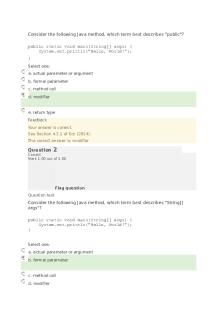Consider the following Java method PDF

| Title | Consider the following Java method |
|---|---|
| Author | winson chisom |
| Course | Programming 1 |
| Institution | University of the People |
| Pages | 4 |
| File Size | 115.9 KB |
| File Type | |
| Total Downloads | 41 |
| Total Views | 162 |
Summary
SELF QUIZ...
Description
Consider the following Java method, which term best describes "public"? public static void main(String[] args) { System.out.println("Hello, World!"); } Select one: a. actual parameter or argument b. formal parameter c. method call d. modifier
e. return type Feedback Your answer is correct. See Section 4.2.1 of Eck (2014). The correct answer is: modifier
Question 2 Correct Mark 1.00 out of 1.00
Flag question Question text
Consider the following Java method, which term best describes "String[] args"? public static void main(String[] args) { System.out.println("Hello, World!"); }
Select one: a. actual parameter or argument b. formal parameter
c. method call d. modifier
e. return type Feedback Your answer is correct. See Section 4.3.2 of Eck (2014). The correct answer is: formal parameter
Question 3 Correct Mark 1.00 out of 1.00
Flag question Question text
What is output by the following Java program? class Compute { static int compute() { return 42; } static int compute(int i) { return i+1; } public static void main(String[] args) { System.out.println(compute(compute())); } } Select one: a. 0 b. 1 c. 2 d. 42 e. 43
Feedback Your answer is correct. The inner call to "compute()" has no argument, so it uses the first definition of the method, which returns the value 42. This 42 becomes the argument to the outer call. Because that call does have an argument, it uses the second definition of "compute". This method then returns 42+1, or 43. See Section 4.3.3 of Eck (2014). The correct answer is: 43
Question 4 Correct Mark 1.00 out of 1.00
Flag question Question text
What is output by the following Java program? Zap { static boolean zap() { return true; } static int zap(boolean x) { return 0; } static double zap(int x) { return 0.5; } static String zap(double x) { return "Zap!"; } static boolean zap(String x) { return false; } public static void main(String[] args) { System.out.println(zap(zap(zap(zap(1))))); } } Select one: a. true b. 0
c. 0.5 d. Zap! e. false Feedback Your answer is correct. The innermost call to "zap" has argument 1, which is an int, so it uses the third method definition, which returns the double 0.5. The next "zap" call then gets this double as an argument, so it uses the fourth method definition, which returns the String "Zap!" So the next call gets a String argument, which means it uses the fifth method definition, which returns the boolean false. The outermost "zap" call gets this boolean, so it uses the second definition and returns the int 0. The first definition of "zap" is never used. See Section 4.3.3 of Eck (2014). The correct answer is: 0
Question 5 Incorrect Mark 0.00 out of 1.00
Flag question Question text
Which one of the following terms does NOT describe a desirable interface to a black box? Select one: a. easy to understand b. implementation c. public d. specification
e. straightforward Feedback Your answer is incorrect. The correct answer is: implementation...
Similar Free PDFs

Following the Correct MLA Format
- 3 Pages

the java switch statement
- 11 Pages

The Audio-Lingual Method
- 2 Pages

The Borda Count Method
- 3 Pages

THE AUDIO-LINGUAL METHOD
- 10 Pages

9.1 The Winkler Method
- 1 Pages
Popular Institutions
- Tinajero National High School - Annex
- Politeknik Caltex Riau
- Yokohama City University
- SGT University
- University of Al-Qadisiyah
- Divine Word College of Vigan
- Techniek College Rotterdam
- Universidade de Santiago
- Universiti Teknologi MARA Cawangan Johor Kampus Pasir Gudang
- Poltekkes Kemenkes Yogyakarta
- Baguio City National High School
- Colegio san marcos
- preparatoria uno
- Centro de Bachillerato Tecnológico Industrial y de Servicios No. 107
- Dalian Maritime University
- Quang Trung Secondary School
- Colegio Tecnológico en Informática
- Corporación Regional de Educación Superior
- Grupo CEDVA
- Dar Al Uloom University
- Centro de Estudios Preuniversitarios de la Universidad Nacional de Ingeniería
- 上智大学
- Aakash International School, Nuna Majara
- San Felipe Neri Catholic School
- Kang Chiao International School - New Taipei City
- Misamis Occidental National High School
- Institución Educativa Escuela Normal Juan Ladrilleros
- Kolehiyo ng Pantukan
- Batanes State College
- Instituto Continental
- Sekolah Menengah Kejuruan Kesehatan Kaltara (Tarakan)
- Colegio de La Inmaculada Concepcion - Cebu









